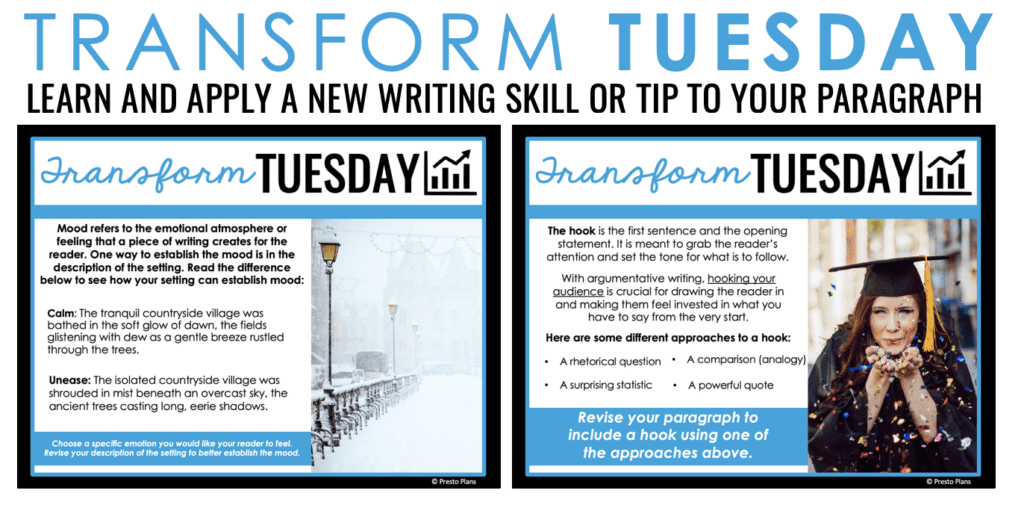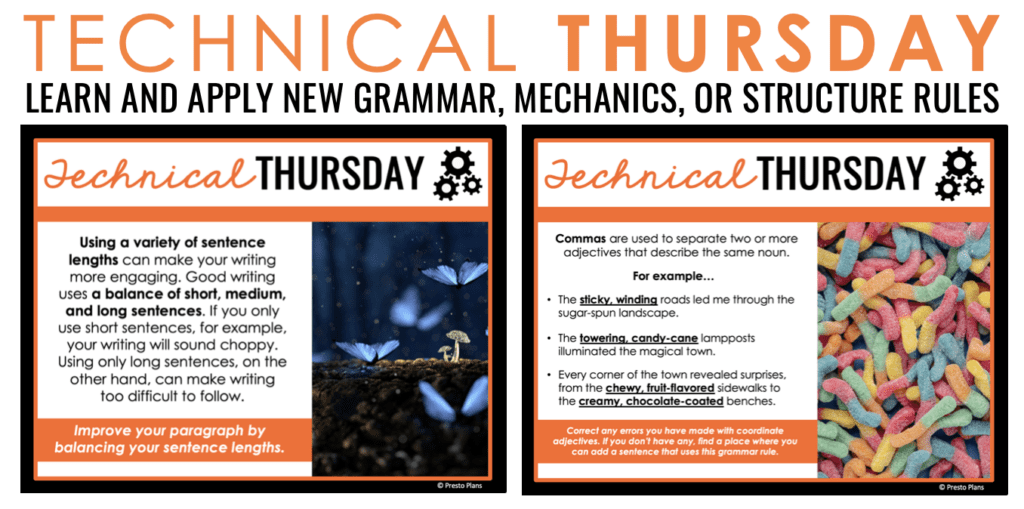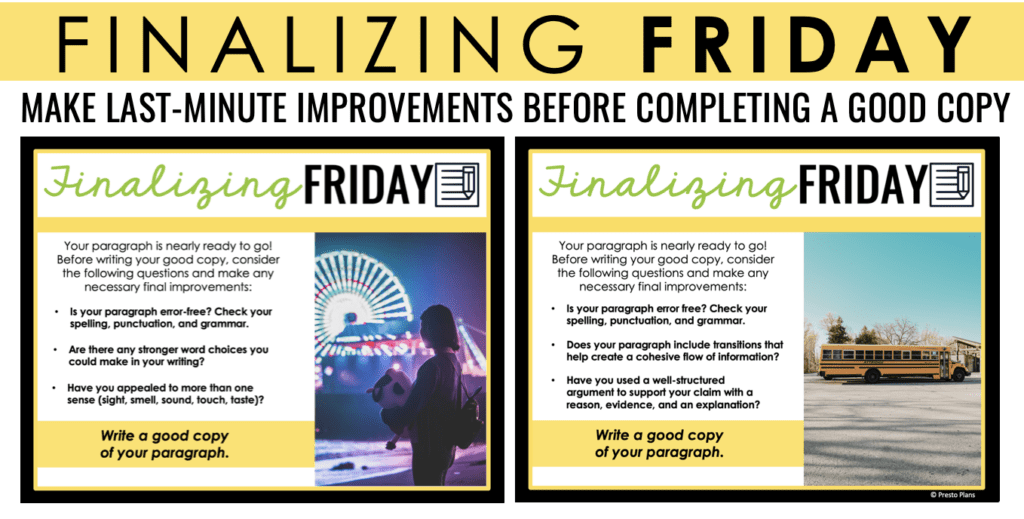PRESTO PLANS
Sent straight to your inbox
CLICK HERE TO ACCESS
Sign up to receive 10 ready-to-use ELA resources your students will love!
10 FREE ELA RESOURCES

How to Use the Paragraph of the Week Program in Middle or High School ELA
When it comes to our writing instruction, it can be easy to get overwhelmed by the number of standards we need to cover over the course of the year. This is why the Paragraph of the Week Program is such a game-changer for the ELA classroom. It provides short and manageable daily tasks that help students practice essential skills related to expository, narrative, argumentative, and descriptive writing.
As a result, middle and high school students become increasingly confident and engaged with the entire writing process. From the teacher’s side, implementing daily bell-ringers can reduce the time spent planning (and marking!) various writing tasks, and create more natural opportunities to gauge students’ progress throughout the year. It also establishes a consistent routine for the beginning of class (which means a few extra minutes for you to take attendance, quickly reply to an email, or simply sip your coffee while it is still hot!).
Here’s how the Paragraph of the Week bell-ringer program works in middle or high school ELA:

One thing that I really appreciate about bell-ringers is how flexible they can be in any ELA classroom. In total, the Paragraph of the Week program contains ten weeks devoted to each of the four writing types (40 weeks in total). This gives each teacher the freedom to select weekly lessons in any order, depending on what writing skill they wish to focus on. Personally, I like to switch it up, rotating between argumentative, narrative, expository, and descriptive writing prompts each week to last the year.
Each week follows the same daily structure outlined below:
Day 1: Musings Monday
To kick off each new week, I like to provide students with a thought-provoking prompt, inspiring them to write a first draft of a paragraph. On Musings Monday, the most important goal is to get ideas down on paper so that students have something to “work with” for the rest of the week! To help get students’ creative juices flowing, try motivating them with a bit of background music, or offer a few minutes of collaborative discussion before the writing begins in earnest. I would recommend setting a timer, though – you don’t want students to get too bogged down in the task! Once the time is up, paragraphs should be set aside until tomorrow.

Day 2: Transform Tuesday
Transform Tuesday is an opportunity for students to practice revision skills. Many teenage writers need support with the “process” of writing, including clarifying and improving their ideas. To begin, have students look back on their writing from Monday, and identify areas where it could be strengthened. For example, if your focus for the week is descriptive writing, you might start this mini-lesson by reminding students that good writers show, rather than tell.
Cue up the provided instructional slides (the Paragraph of the Week program contains more than 200 instructional slides to accompany the daily lessons!) As you work through the lesson, point out examples to illustrate how students can look for areas of improvement in their writing.
For example, “showing” might look like this:
- I found myself in a lush jungle. It was very hot.
Meanwhile, a “telling” example might look more like this:
- The air was thick and heavy, carrying the scent of damp earth and lush foliage. Beads of sweat formed instantly on my brow and trickled down my face.
Once you’ve discussed a few examples, students can take a few moments to apply their new learning. I like to ask them to identify at least one sentence where they are “telling” and revise it so they are “showing” instead.

Day 3: Wordsmith Wednesday
It’s the middle of the week, and time for students to revisit their paragraph with fresh eyes. On Wordsmith Wednesday, I like to encourage them to elevate their writing through rich and vivid word choices. This could include a mini-lesson on figurative language terms, or other literary techniques. The provided Paragraph of the Week slides include examples of figures of speech (simile, metaphor, and many others). Once students have reviewed and discussed these examples, I ask them to consider how they could be applied to their paragraph.
Rather than overwhelm students with all the different improvements they could make, I prefer to target just one area of improvement per prompt. This also helps me identify when students are ready for a new challenge, and when they need to go back and practice a skill again. I like to have students keep a copy of all their revisions from the entire week in a notebook that I can periodically collect and review. While I don’t usually grade their work in progress, reviewing each student’s writing (and spending a few minutes to conference with them) can help me pinpoint their strengths and struggles, and support them accordingly.

Day 4: Technical Thursday
On Technical Thursday, the focus shifts to writing mechanics, sentence structure, and grammar. I prefer to hone in on just one or two writing skills at a time. For example, you might use a guided lesson to help students understand how to add variety to sentence lengths in their paragraph.
Regular, low-stakes opportunities to troubleshoot common writing issues, such as repetition or syntax errors, help middle and high school ELA students grow as confident, capable writers. I also like to use daily writing bell-ringers, such as the Paragraph of the Week program to reinforce the importance of revision and editing as part of the writing process.

Day 5: Finalizing Friday
To wrap up the Paragraph of the Week bell-ringer program, students finalize good copies of their paragraph. Here, I like to provide support in the form of a final checklist. This helps middle and high school writers clearly understand the expectations for each task, and supports them in producing their best work.
Typically, I like to incorporate some sort of assessment or reflection into my routine for Finalizing Friday. This can consist of opportunities for individual or small-group conferencing (my goal is to have a brief conference about writing with each student once a month), or periodic written reflections about their growth as writers. I also have students maintain a portfolio of all their weekly paragraphs, showing the progress from the first draft to good copy. I regularly do a quick “check” of these portfolios to gauge growth and identify trouble spots. From time to time, I also let students choose one paragraph (per month, or even per quarter) for me to grade.

There you have it! I hope these writing bell-ringers can help reduce stress and give you back your valuable time! Click the link below to grab the ready-to-use program today.

Still curious about how to make bell-ringers work for your classroom? Check out this post: Using Bell-Ringers in ELA – Answers to Your 10 Most Asked Questions!
Are your students struggling to settle at the beginning of class? Calm the chaos and set the tone with these creative ideas! 7 Bell-Ringer Ideas for Middle and High School English
Search the blog for what you are teaching
GIVEAWAYS
sent straight to your inbox!
share this post